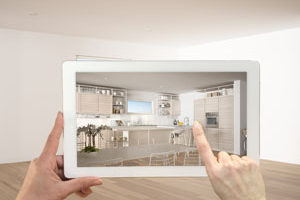Immersive online shopping experiences include augmented reality (AR) that allows consumers to engage deeply with items through a seamless combination of real world and digital elements.
The majority of shoppers want to touch, try on and interact with a product before buying it. At the same time, 48% of Americans don’t want to go to brick and mortar stores right now for safety reasons. Immersive shopping fulfills both needs, significantly increasing purchases. Additionally, consumers say AR enhances their connection to brands that use it.
Shoppers’ favorite immersive experiences are spinning products through 360 degrees, seeing items in real life environments, and virtually trying on make-up and clothes. All three have a stronger influence on purchase decisions than consumer ratings and reviews.
Heavy users of AR are exactly who you imagine (young, affluent, committed online buyers.) However, 72% of consumers are aware of augmented reality, and 40% have already used it at least once while shopping.
Roughly two-thirds of leading brands are investing in immersive experiences. Noteworthy examples include Ulta Beauty’s GLAMLab app for virtually trying on make-up and Francesco Rinaldi’s AR package label that delivers their product story when scanned with the brand’s app.
Sources: Accenture 2020, Forbes 2020, Martechseries 2020

 So please…You’re creative. That’s why you considered the name “Brandology.” Use those creative juices to come up with another name that’s not already trademarked. Even though it will take some time, it will be fun, happy time — a stunning contrast to the time you’ll spend with Brandon if you try to use “Brandology.” Really. (It’s probably a little tacky to mention, but if you want our help naming your business, that’s something we do too.)
So please…You’re creative. That’s why you considered the name “Brandology.” Use those creative juices to come up with another name that’s not already trademarked. Even though it will take some time, it will be fun, happy time — a stunning contrast to the time you’ll spend with Brandon if you try to use “Brandology.” Really. (It’s probably a little tacky to mention, but if you want our help naming your business, that’s something we do too.)